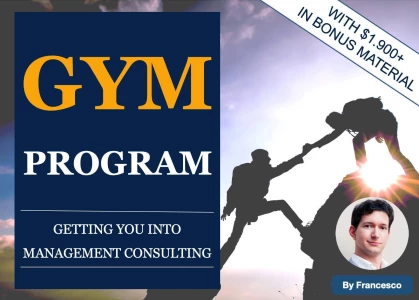1. Read and analyse the data on the fly, doing calculations as you go.
2. Ask for time, present an approach, then go through numbers with the interviewer.
3. Present an approach on the fly, then go through numbers with the interviewer.
1. Read and analyse the data on the fly, doing calculations as you go.
2. Ask for time, present an approach, then go through numbers with the interviewer.
3. Present an approach on the fly, then go through numbers with the interviewer.


Hi there,
Q: Which approach for numerical questions is best?
Out of those you listed, #2 is the best. The reasons are:
So #2 > #3.
Approach #1 is not ideal as if you analyze on the fly you risk to miss something.
- - - - - - - - - - - - - - - - - - - - - - - - - - - - - - - - - - - - - - - - - - - - - - - - - - - - - - - - - - - - - - - - - - - -
In terms of how to approach math during the case, this is what I would recommend:
- - - - - - - - - - - - - - - - - - - - - - - - - - - - - - - - - - - - - - - - - - - - - - - - - - - - - - - - - - - - - - - - - - - -
In terms of general math tips and avoiding mistakes, I would recommend the following:
- - - - - - - - - - - - - - - - - - - - - - - - - - - - - - - - - - - - - - - - - - - - - - - - - - - - - - - - - - - - - - - - - - - -
I would also recommend to practice math under pressure - not just math. Many candidates are totally fine doing 67% of 67 in normal conditions, but freeze if asked this suddenly in a case interview.
In order to do so, try always to use a timer with a time constraint when you practice math – this will create pressure and help to replicate the actual conditions of the interview.
Hope this helps,
Francesco

Hi there,
Please do not extract conclusions on the fly.
If you have a clear obvious conclusion off the bat (because it's an exhibit), then say it!
However, I recommend you:

Hi,
The best approach for numerical questions may vary depending on the specific context and interviewer preferences. However, generally, approach 2 is most effective in my experience.
First, take a moment to understand the problem and the data provided. Then, present an approach or a framework for how you plan to tackle the problem. This shows the interviewer that you have a logical and structured way of thinking about the problem.
Next, work through the calculations or analyses with the interviewer, explaining your thought process as you go. This allows the interviewer to understand your reasoning and to provide guidance or clarification if needed. It also demonstrates your ability to communicate effectively and collaborate with others.
Generally, try to avoid doing things “on the fly” because that will usually cause errors.
/Marvin

Always number two! You want to take a bit of time to think through how you're going to approach the problem then, once you have a methodology, explain it to the interviewer so that they understand what you're going to do and course correct you if it's a little off, then talk through the numbers as you do them with the interviewer.
Good luck!

Hi there,
I think this is an interesting question that may be relevant for many people. I would be happy to share my thoughts on it:
If you would like a more detailed discussion on how to best prepare for your upcoming interviews, please don't hesitate to contact me directly.
Best,
Hagen

Hi there,
Number 2 is the closest to best practice.
Best,
Cristian

Hi there,
it really depends on the complexity of the question/data at hand. If it is a simple calculation, you should do it on the fly. For everything else usually your approach (2) is best.
Andreas

First you structure an approach and explain it, then you execute it. This is hands-down the best way to do it.

#2 is best - you always want to take a little bit of time to process the information you are being given and start formulating an approach. I would do the following: ask for time, ask any clarification questions as needed, present a brief approach, then perform the calculation and go through the numbers with the interviewer. The latter two parts are a bit more fungible - some candidates like to voice their calculations over as they go, while others like to calculate the numbers first, and then present their answers when they're done. An approach like this will increase your chances of arriving at the correct answer and being able to present it in a way that's logical and easy to follow, compared to doing things on the fly.












